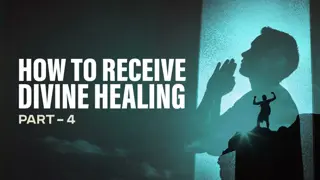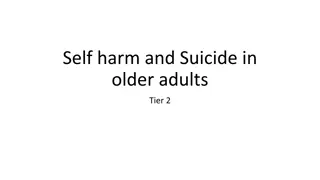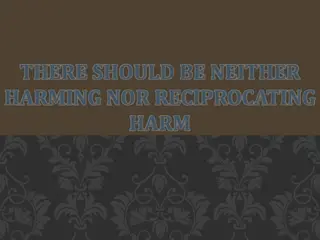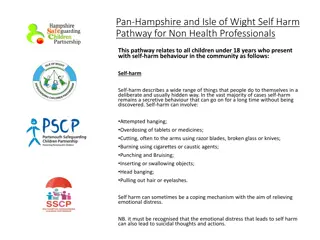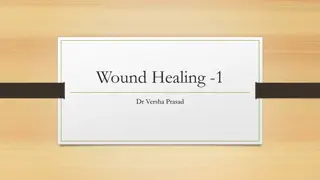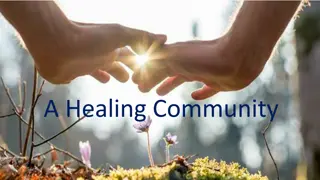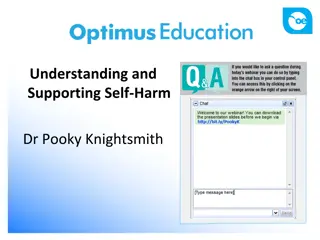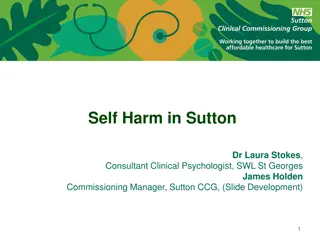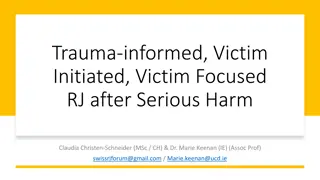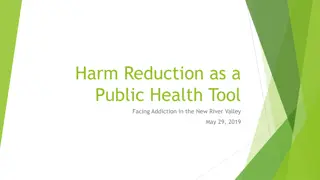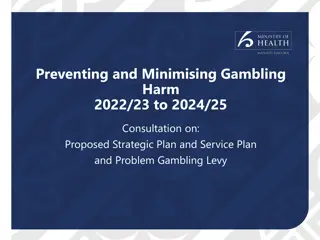Understanding Self-Harm: A Path to Healing
Exploring the complexities of self-harm as a cry for help and a way to regulate emotions. Emphasizing the importance of listening, understanding, and accepting individuals struggling with self-harm behaviors to guide them towards change and healing.
Uploaded on Oct 04, 2024 | 0 Views
Download Presentation

Please find below an Image/Link to download the presentation.
The content on the website is provided AS IS for your information and personal use only. It may not be sold, licensed, or shared on other websites without obtaining consent from the author. Download presentation by click this link. If you encounter any issues during the download, it is possible that the publisher has removed the file from their server.
E N D
Presentation Transcript
Dylan Moore, Richard Booth and Tara Deehan Psychology Department St. Patrick s Mental Health Services Walking the Middle Path
Finding a Middle Path ACCEPTANCE CHANGE
What is self-harm? Self-poisoning or self-injury regardless of the intent associated with the act A complex phenomenon Self harm and suicide are separate behaviours Link between self harm and suicide
Understanding functions of self-harm Serves different functions for different people Assuming the function can block us understanding the individual
Regulating emotion Main function shown to be managing unbearable emotions More sensitive to emotions Missing the skills to manage these emotions
Listening and understanding It is understandable that this has come to be Feeling understood is more likely to lead to openness to change
The person is doing the best they can and at the same time
The person is doing the best they can and at the same time They need to do better, try harder and be more motivated to change
Take home Self harm serves different functions for different people at different times Main function is to manage unbearable emotion Listening and understanding can increase the likelihood of getting help This is hard for all involved
Preventing bullying will reduce self-harm
Dumbo video clip https://www.youtube.com/watch?v=dXRyak6N_sw
A B
Animals should not Circuses should not Ringmasters should not Children should not
Bullying Rejection Difficulties at home Difficulties at school
Preventing bullying will reduce self-harm
Dealing with self-harm is for experts
Responding to self-harm Formal support should always be considered for somebody who is engaging in self harm BUT first disclosure tends to be within informal support structures e.g. friends, family Initial reactions can play an important role in further disclosures and help seeking behaviour so having some helpful ways of responding can be important
Regulate your own emotion Feeling the pressure to get it right Pause, take a breath and notice your own thoughts and emotions Observe and validate yourself it is understandable that I m feeling like this, I care about this person so of course I feel like this ACCEPTANCE CHANGE
Regulating emotions paced breathing Paced Breathing is slowing our breathing down Exhale for longer than you inhale, i.e. breathe in for 4 and out for 6 Research has demonstrated it can quickly bring down emotional distress Lots of apps that support this, some with visual aids
Validate the person honour the kernel of truth in the other s perspective What is understandable about how they are feeling, thinking or behaving? It is not agreeing or approving This helps bring down emotion and help the person feel heard ACCEPTANCE CHANGE
How to validate Actively listen, make eye contact and stay focused Be mindful of your verbal and nonverbal reactions Observe what the person is feeling in the moment (tentatively) Reflect back the feeling without judgement Remember why you re validating: reduces distress and helps them be understood
Listen If the person is willing and calm enough to tell you what is going on, ask them: What happened? What is going on for you? We might want to know everything and ask lots of questions but this might be overwhelming. If they become distressed move back to validation. ACCEPTANCE CHANGE
Brainstorm If the person is ready, collaborate on identifying the next steps All options and ideas are welcome What do they need? What might help? Bearing in mind there maybe some steps that need to be taken, i.e. notifying parents, services etc. ACCEPTANCE CHANGE
Support Good to familiarise yourself with what s in the community? How can you provide support for the next steps? What role would they like you to play? Who else might they like to involve? ACCEPTANCE CHANGE
Take home Take care of yourself Be present for the person through working to understand them and ourselves Look to support them while knowing your own limitations ACCEPTANCE CHANGE
Dealing with self-harm is for experts



